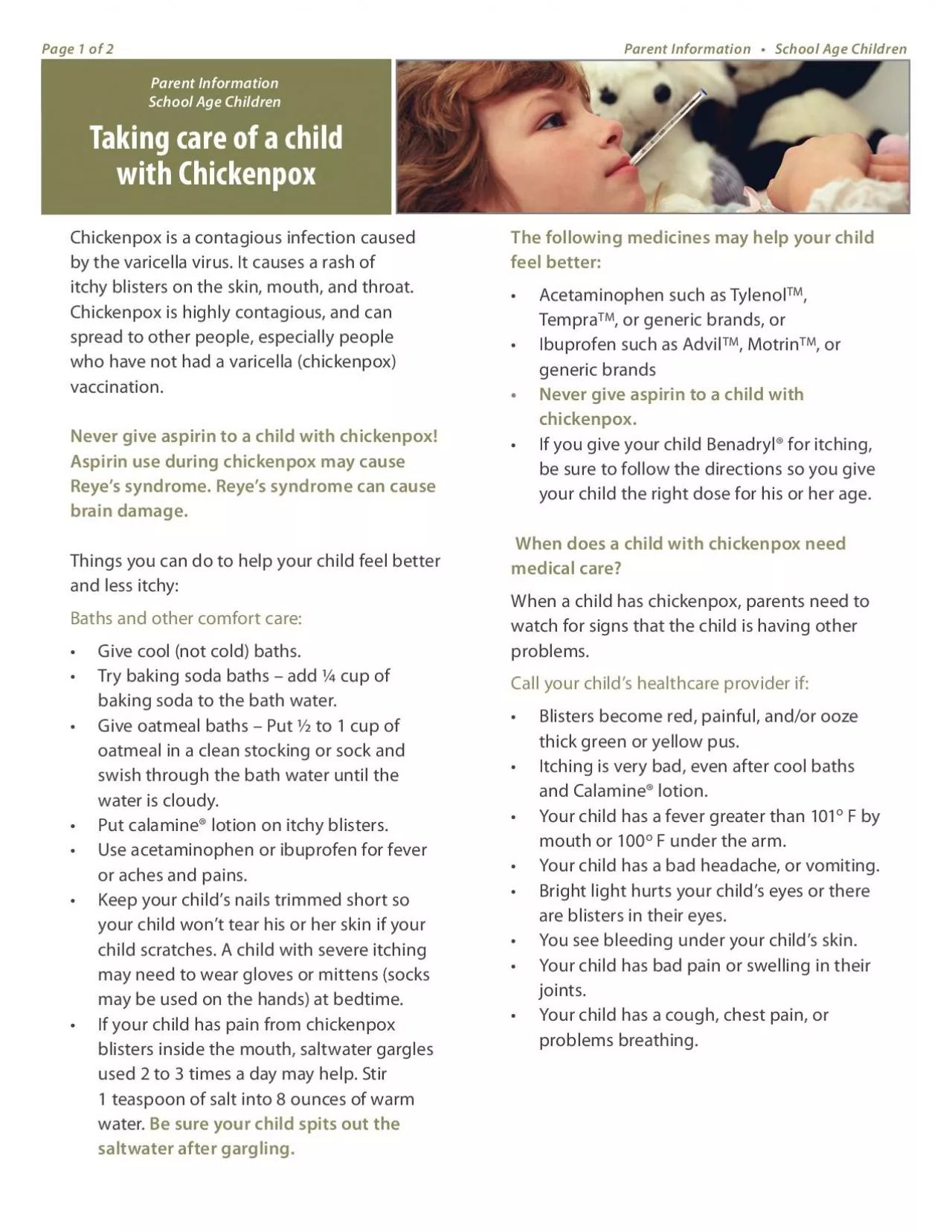

by the varicella virus It causes a rash of itchy blisters on the skin mouth and throat Chickenpox is highly contagious and can spread to other people especially people who have not had a var ID: 939983
Download Pdf The PPT/PDF document "Chickenpox is a contagious infection cau..." is the property of its rightful owner. Permission is granted to download and print the materials on this web site for personal, non-commercial use only, and to display it on your personal computer provided you do not modify the materials and that you retain all copyright notices contained in the materials. By downloading content from our website, you accept the terms of this agreement.
Chickenpox is a contagious infection caused by the varicella virus. It causes a rash of itchy blisters on the skin, mouth, and throat. Chickenpox is highly contagious, and can spread to other people, especially people who have not had a varicella (chickenpox) vaccination. Never give aspirin to a child with chickenpox! Aspirin use during chickenpox may cause Reye’s syndrome. Reye’s syndrome can cause brain damage. Things you can do to help your child feel better and less itchy: Baths and other comfort care: Give cool (not cold) baths. Try baking soda baths – add ¼ cup of baking soda to the bath water. Give oatmeal baths – Put ½ to 1 cup of oatmeal in a clean stocking or sock and water is cloudy. Put calamine® lotion on itchy blisters. Use acetaminophen or ibuprofen for fever or aches and pains. Keep your child’s nails trimmed short so your child won’t tear his or her skin if your child scratches. A child with severe itching may need to wear gloves or mittens (socks If your child has pain from chickenpox blisters inside the mouth, saltwater gargles used 2 to 3 times a day may help. Stir 1 teaspoon of salt into 8 ounces of warm water. Be sure your child spits out the saltwater after gargling. The following medicines may help your child feel better: Acetaminophen such as Tylenol , Tempra TM , or generic brands, or Ibuprofen such as Advil TM , Motrin TM , or generic brands Never give aspirin to a child with chickenpox. If you give your child Benadryl® for itching, your child the right dose for his or her age. When does a child with chickenpox need medical care? When a child has chickenpox, parents need to watch for signs that the child is having other problems. Call your child’s healthcare provider if: Blisters become red, painful, and/or ooze thick green or yellow pus. Itching is very bad, even after cool baths Your child has a fever greater than 101 o F by mouth or 100 o F under the arm. Your child has a bad headache, or vomiting. Bright light hurts your child’s eyes or there are blisters in their eyes. You see bleeding under your child’s skin. Your child has bad pain or swelling in their joints. Your child has a cough, chest pain, or problems breathing. Parent Information • School Age Children Page 1 of 2 Taking care of a child with Chickenpox Parent Information School Age Children htt
p://www.scdhec.gov/health/mch/wcsBureau of Maternal & Child Health • Division of Women & Children’s Services • DHEC-2336 7/2011 Your child may need to be seen in the Emergency Department if he or she is having any of the following problems: • Difficulty breathing • A severe cough • Sleepiness and difficulty in waking up • Confused or combative manner • Seizure • A fever of 103 F or higher, a bad headache, or vomiting.Call before taking your child to his or her healthcare provider. The clinic or office may want you to bring your child to a special waiting room so other children won’t be exposed to the chickenpox virus.How to keep chickenpox from spreading to other people: • Keep your child with chickenpox away from other people. • Wash your hands often when you care for your child. Have your child wash his or her hands often too. • Have your child use a tissue when coughing or sneezing, then throw the tissue away. • Make certain that you and your children are up-to-date on your vaccinations. Some children who have the chickenpox shot may get chickenpox, but they will have a milder case, with less fever and fewer bumps.Your child must stay home from school and/or child care.Children usually go back to school or child care when all of the following have occurred: • All the blisters have dried and crusted (usually 6-7 days after the onset of rash) • The child feels well, and • The child’s temperature is normalChildren who develop chickenpox after getting the chickenpox shot may have mild or “breakthrough” illness. Children with “breakthrough” chickenpox disease may not have blisters or crusting of blisters. These children should return to school when the mild rash has faded and no blisters are present. For additional information about exclusion when a child has chickenpox, see the DHEC Child Care and School Exclusion Lists of Contagious or Communicable Diseases at www.scdhec.gov/health/disease/exclusion.htm Brand names used in this document are only meant to be examples. DHEC does not endorse any of the brand names in this document.Parent Information • School Age ChildrenTaking care of a child with chickenpox(continued)Parent InformationSchool Age Children Page 2 of 2 Child’s NameSchool NurseDateSchoolSchool Phone Number